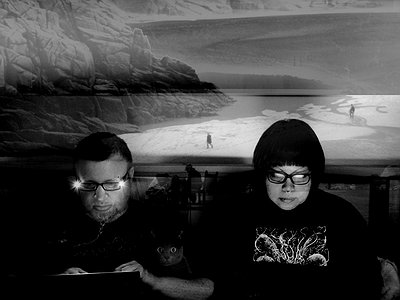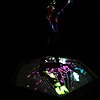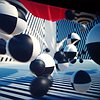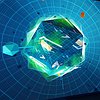Name: Shi & Kriss Blank
Occupation: Game Developers / Digital sound artists
Currently working on: Candy Ghosts / Outlands Tour with Kyoka and Grischa Lichtenberger
Recommendations: Kriss- Pixel Juice by Jeff Noon, because it is so dense, full of interesting ideas and slightly absurd. Shi- Cosmic Trigger: v. 1: Final Secret of the Illuminati by Robert Anton Wilson - because I hallucinated after reading it in one sitting / D’un soir triste by Lili Boulanger - the last piece of music the remarkable French composer scored by hand. The first time I heard this, I was overwhelmed with grief from the death of my non-biological mother.
Website/Contact: Learn more about Wetgenes on their website wetgenes.com
When did you start creating designs and layouts for music - and what or who were your early passions and influences? What is it about the relationship between music and design that drew you to it?
Shi: I made zines as a teen - it was a natural extension of an insatiable appetite for music and design. I was classically trained on the piano but I also played bass in an all-girl punk band and hung out with turntablism enthusiasts, so it was all about pushing things further to see where I could go. With skateboarding, I developed an appreciation for architecture and the design of public spaces - it meant looking out for curbs and structures that did not have anti-skate devices and deterrents.
I read a lot of skateboarding magazines, local and international and from there, I hooked up with a network of other creatives and musicians. Instrumental hip hop, jazz & trip hop like DJ Krush, Shadow and Vadim were on repeat a lot - I favoured music without vocals unless it was death metal. By this time, I was attending art college and I consumed a tonne of graphic design publications, specifically those that were typography-based, Arkitip, Die Gestalten Verlag stuff, etc. Later on, it was Joshua Davis with his immense contribution to digital art - Praystation, Dreamless and Once-upon-a-forest websites. My zines ultimately became digital & lived as websites and animations; strange designs intertwined with music but they are dead Geocities now. Visual sans auditory feels incomplete.
Kriss: I started very young, 10 or 11, something like that. And it’s always just been mucking around with computers. MC Escher very much influenced everyone back in the 80s; the breaking down of space into positive and negative and repeating patterns had a strong impact on what I was trying to do.
For most artists, originality is first preceded by a phase of learning and, often, emulating others. How would you describe your own development as an artist and the transition towards your own voice? What is the relationship between copying, learning and your own creativity?
Shi: I grew up in a place where I was the lucky kid with the computer. None of my friends knew what one was. I remember being 6 and playing with dos when left on my own. I had no peers and my parents barely knew what to do with it but somehow it seemed something natural and intuitive for me to work with. So, in a way, transitioning towards my own voice was easier without the influences of others.
Kriss: I think there was probably very little copying as I was in an unexplored space - if you look at the early days of computer games, nobody knows what they’re doing. There really isn’t anything to copy, everyone’s just making it up as they go along and we’re sort of learning from each other. In a way, we were influencing each other from what we were making up, as there were no set rules to do things back then - no old masters to look up to or copy from - we were stumbling around and making our own way in this new medium.
What were your main design challenges in the beginning and how have they changed over time?
Shi: Expressing all the chaos in my head into a decision on the medium-of-choice has always been a challenge. When I began to code, it became clear that it was the most liberating and pleasurable medium to work with.
Kriss: The challenge is always about trying to balance the technical with the art side of things. So, you end up spending 99% of your time just fighting technical problems and then you’ve only got 1% left to attempt any artistic decision. So, whenever you involve technology in art, the tech takes up a majority of time and the creative part gets squeezed smaller and smaller until the deadline comes along and you’re just doing the first thing that comes into your head.
What makes for a great music-related design? What are the differences in terms of approach for different formats like posters, flyers and covers?
Shi: Typography and tactile materials. I love Kate Stone’s conductive ink paper projects as an update to the medium. Traditionally, the different formats are trying to do different things - they have different shelf-lives. Posters should grab your attention and give you all the details you need at a glance from afar, flyers should tempt you to pick them up and covers are novelty items you want to bring home and stare at or show off. Torn posters are the best versions of the format - I wonder if you could do glitch music if you apply that concept to conductive ink paper.
Kriss: That’s not really the sort of thing I do - I’m very much an ‘understand the numbers’ person. It’s all about taking the numbers and turning them into something else. So basically, turn music into interesting numbers and from there, turn it into something else - transforming and taking something as an input and then knowing what to do to it to get what I want. This is achieved by tweaking and lots of feedback from said tweaks until I’m happy with what the input is creating in the output.
What kind of relationship is there between the cover of a release and the music? What can the visual layer add or change about the music? Would you say the end result is an art work in its own right, a fusion or merely a support of the music?
Shi: This reminds me of the issue of comic covers. I don’t know how it happened or who started it but comic covers are never the same style as the art in the comic itself - it’s very deceiving. It’s like judging a book by its cover and being totally ok with the deception. With music, it’s probably more like an inverted ‘symphonic poem’ - the cover sets the tone of what possible music the release might contain. The resulting effect of listening to it, however, is up to the listeners’ interpretation - if the art is deception or poem.
How do you make use of technology? In terms of the feedback mechanism between technology and creativity, what do humans excel at, what do machines excel at?
Kriss: Everything we do makes use of technology. Machines are good at doing simple things repeatedly, exactly the same thing, millions of times. And that’s the real difference. What you have to work out is what the simple thing that you’re going to be doing millions of times is and how to get an interesting result out of that. The creative act is what humans provide.
Collaborations can take on many forms. What role do they play in your approach and what are your preferred ways of engaging with the artists you're working for?
Kriss: The problem with time (and sanity) management is balancing the technical side of things with the artistic, it’s very hard to switch your mind-set back and forth so if you’re collaborating with others that are more artistic and less technical, you can let them handle the art side of things when you’re worrying about horrible technical details and then you can bounce off them when you’re back into the art space; it works better as a form of synergy.
However, at the same time you’re also providing the art and whilst somebody else may make suggestions, ultimately, it’s still down to solving the technical complexities to make it happen which means you’re completely in control of the output. But having somebody else do the deep thinking when you’re stuck in a technical hell is very useful because you can come back to them and it’s easier to get back into that space.
Could you take us through a day in your life, from a possible morning routine through to your work? Do you have a fixed schedule? How do music and other aspects of your life feed back into each other - do you separate them or instead try to make them blend seamlessly?
Shi: Lots of input to drown things out and get lost in, is critical for me. No vocals though and the louder, the better. My daily routine depends on what the calendar dictates - I do quite a bit outside of coding so if I have to go somewhere, it is usually get up and go. I don’t really have a fixed schedule - I mean, I try to but something always comes up. Music is vital in my life - I’m a cellist in an orchestra every fortnight and we perform concerts so a huge chunk of my time also goes to learning new repertoires. There are many aspects of cello-playing that are similar to coding - I’m always learning new techniques and updating the current ones. In a way, they complement each other and cannot be separated.
Kriss: A day in my life is a rather boring experience - I get up, sit in front of a computer - eventually finish my coffee, I get hungry so I have to stop and eat something and then I go back and sit in front of the computer until it’s late - whenever I’m working, I do like to have lots of things happening in the background - so there’s always TV, music or just lots of input going on the background just to stare away at when things get a little bit too intense and I just can’t take the technical hell anymore.






